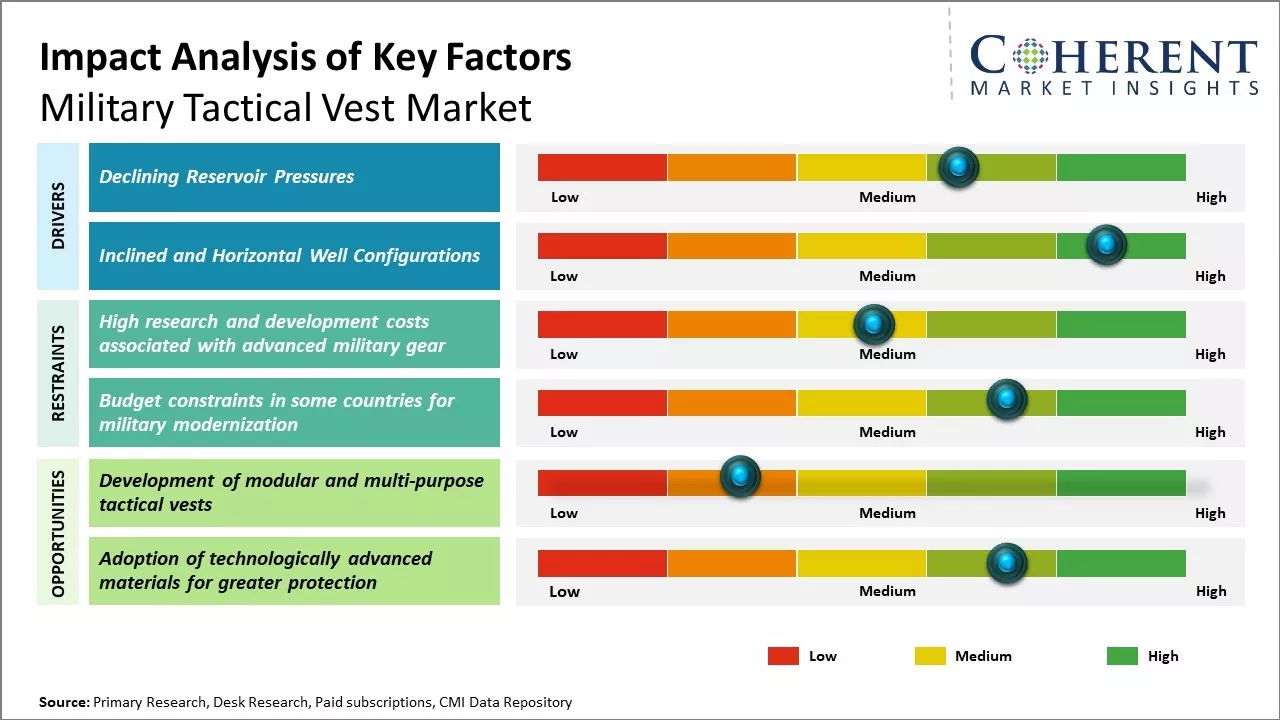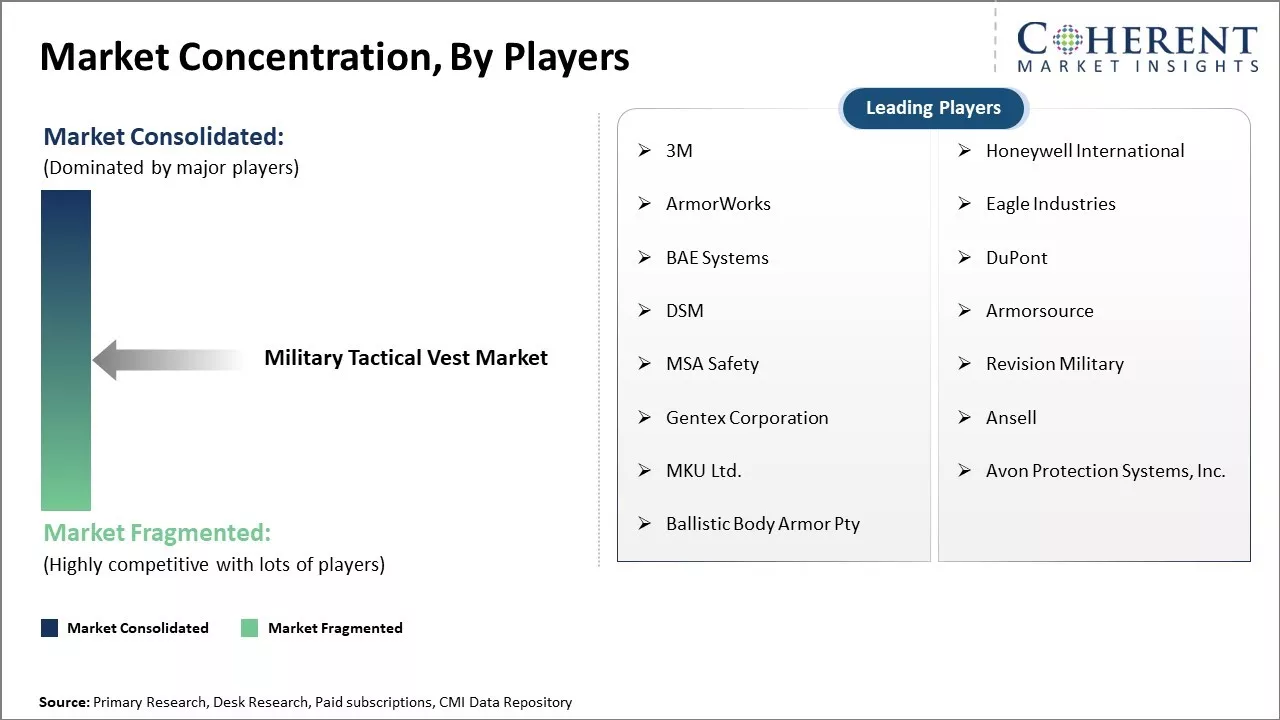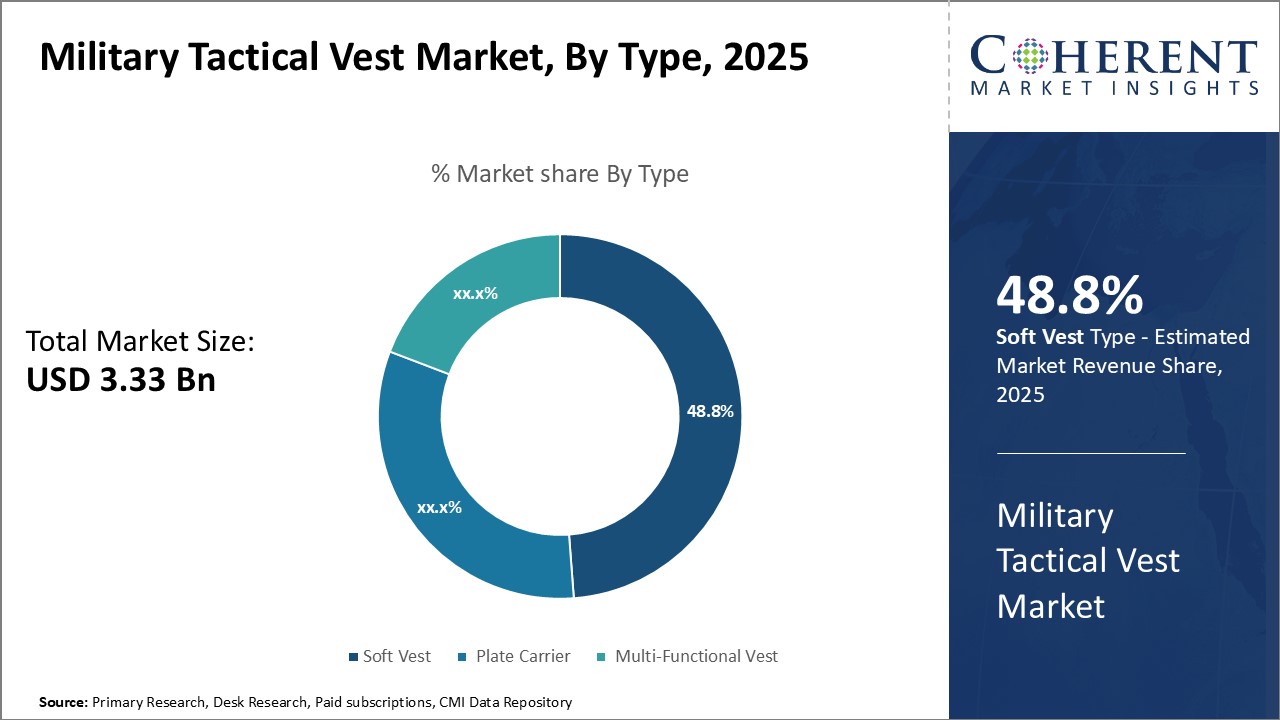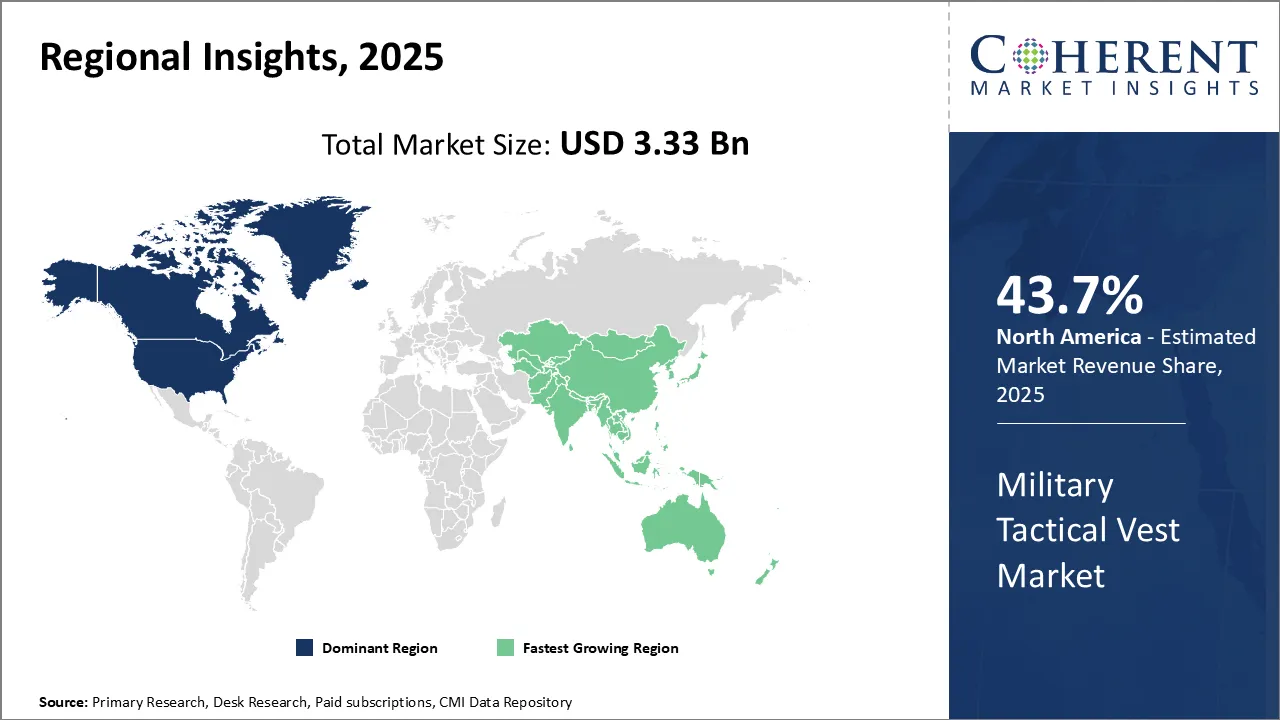Military Tactical Vest Market Size and Trends
Global military tactical vest market is estimated to be valued at USD 3.33 Bn in 2025 and is expected to reach USD 5.05 Bn by 2032, exhibiting a compound annual growth rate (CAGR) of 6.1% from 2025 to 2032.

Discover market dynamics shaping the industry: Download Free Sample
Rising adoption of lightweight and advanced combat vests by militaries across the globe is expected to drive the market growth during the forecast period. Countries are procuring technologically advanced tactical gear like ballistic vests, combat vests, Molle vests and load bearing equipment to enhance the protection and operational effectiveness of their soldiers. Rising geopolitical tensions and increasing defense modernization budgets boosts demand for military tactical vests. Advanced fabrics with better ballistic and stab resistant properties along with added features like concealed armor, pockets, pouches and harness are gaining popularity, however, high procurement costs can hamper the market growth.
Rising Geopolitical Tensions and Territorial Disputes
With changing geopolitical landscape, there has been rising tension between countries on issues relating to territorial boundaries and regional hegemony. Several flashpoints have emerged over the past decade that threaten to escalate into full-blown military conflicts. This includes ongoing disputes in the South China Sea between China and other claimants like Vietnam, Philippines, and Taiwan. China has been increasingly aggressive in asserting control over the region that encompasses vital shipping lanes. There are overlapping claims by multiple countries, and military posturing has heightened the risks of confrontation.
In Europe, Russia's actions in Ukraine and annexation of Crimea have severely strained its relations with Western nations. This has led NATO to improve its defensive capabilities near Russian borders. Meanwhile, other countries are also facing border tensions and security challenges. The longstanding conflict between India and Pakistan over Kashmir occasionally flares up. North and South Korea remain technically at war despite recent thawing of tensions. With political volatility and lack of trust between opposing sides, there is always a threat of the situation escalating.
These geopolitical flashpoints increases the need for modernizing and enhancing military equipment. Tactical vests provide safety and allow soldiers to carry necessary gear into combat situations. These are mission-critical for frontline troops who may have to engage in combat operations at short notice due to territorial provocations. With the possibility of conflicts breaking out or tensions escalating quickly, countries want to ensure their forces are equipped with the latest protective gear. This boosts demand for advanced tactical vests that can withstand newer weapons and provide full-spectrum protection. Governments are prioritizing defense spending to deter aggression from rivals, creating opportunities for the tactical vest industry.
Market Concentration and Competitive Landscape

Get actionable strategies to beat competition: Download Free Sample
Enhanced Threat from Non-State Actors and Terror GroupsRising geopolitical tensions along with threat from non-state militant groups can drive the market growth. Terrorism and insurgencies have become a global challenge exacerbated by political turmoil and sectarian conflicts in many regions. Decades of warfare in Afghanistan and Iraq spawned radical terrorist networks like Al-Qaeda and ISIS that have spread their violent ideologies beyond these war zones. Ethno-religious insurgencies in places like Southeast Asia, Africa and parts of Europe pose security problems.
Key Takeaways from Analyst:
The global military tactical vest market is expected to witness steady growth over the forecast period owing to increasing defense spending of major economies and modernization of armed forces with advanced protective gear. The demand for lightweight ballistic protection to provide safety and mobility to soldiers sees a rise. North America currently dominates the market and is expected to continue its dominance backed by high investments in R&D and new procurement projects by the US and Canada. The Asia Pacific region is likely to emerge as the fastest growing market with the increasing defense budgets of India, China, and other Southeast Asian countries.
However, budget constraints of certain countries may impact the demand adversely. Developing innovative lightweight and comfortable fabrics for tactical vests remains a big challenge due to high costs involved. Dependence on a limited number of global players for key materials can also affect the steady supply of tactical vests. Emphasis on procurement of locally manufactured tactical equipment challenges the market to some extent. The increasing instances of asymmetric warfare and rising terrorism activities are highlighting the need for multifunctional tactical gear, thereby opening new opportunities. Integration of advanced technologies like GPS trackers and bulletproof nanocomposite materials in vests will likely drive future demand.
Market Challenges: High research and development costs associated with advanced military gear
One of the major challenges faced by manufacturers in the military tactical vest market is intense competition from global and regional players.
High research and development costs associated with product innovation and integration of new features like bulletproof components can hamper the market growth. Strict government regulations surrounding the procurement of defense equipment also makes it difficult for new entrants. Additionally, declining defense budgets in major markets like the U.S. and Europe exerts pricing pressure on manufacturers.
Market Opportunities: Development of modular and multi-purpose tactical vests
Developing economies are increasing their defense spending, and this can offer opportunities for the market growth. Many Asian countries are procuring new-age tactical gear to modernize their armed forces. This boosts demand for lightweight bulletproof vests with advanced camouflage and concealment features. Manufacturers can also explore opportunities in the commercial security and law enforcement equipment segments.

Discover high revenue pocket segments and roadmap to it: Download Free Sample
Insights, By Type: Evolving material technology boosts soft vest segment growthIn terms of type, soft vest segment is estimated to contribute the highest share of the market owing 48.8% in 2025 to evolving material technology. Soft vests are popular among military and police personnel due to their lightweight and flexible characteristics. Continuous innovation in material science has enhanced ballistic resistance and comfort of soft vests. The introduction of high-performance synthetic fibers like Dyneema and Spectra has elevated ballistic protection offered by soft vests. These ultra-strong fibers absorb and deflect bullets effectively while maintaining moisture-wicking and breathability. Some soft vests even integrate plate pockets to provide additional protection against rifle shots. Cut-resistant and abrasion-resistant fabrics in soft vests also shield the wearer from knife attacks and blows. As modern warfare and law enforcement operations involve varied terrains, soft vests have gained appeal owing to their flexibility and pliability over rigid plate carriers.
Insights, By Application: Increased militarization of police bolsters multi-functional vest demand
In terms of application, the police segment is estimated to contribute the highest market share owing 63.7% in 2025 to increased militarization of law enforcement agencies. Multi-functional vests have become immensely popular among SWAT teams and other specialized police units engaged in high-risk operations. These vests facilitate integration of accessories like holsters, pouches, shields and trauma plates to provide ballistic protection as well as carry gear. Customizable modular designs of multi-functional vests allow incorporation of equipment as per tactical requirements. Rapid intervention, counter-terrorism and active shooter response mandates has boosted demand for multi-functional vests from militarized police forces worldwide.
Insights, By Protection Level: Rising gang violence propels Level II & Level IIA protection sales
In terms of protection level, level II segment is estimated to contribute the highest share owing 33.6% in 2025 due to rising incidences of gang violence and organized crime. Level II and Level IIA vests offer protection against 9mm and .40 S&W rounds which are commonly used in pistol crimes. Escalating conflicts between criminal networks have increased risks confronted by military and police personnel on internal security duties. This has boosted procurement of entry-level but effective ballistic protection vests. Level II and Level IIA vests maintain a balanced profile of ballistic resilience and wearability for long duty hours. Their lighter weights and pliability make them preferable for patrol and undercover operatives confronting everyday threats. Hence, these mid-range protection vests will witness huge demand from security agencies amid turbulent law and order situations.
Regional Insights

Need a Different Region or Segment? Download Free Sample
North America has dominated the global military tactical vest market over the past decade and hold the largest market share owing 43.7% in 2025 The region has strong military presence across all branches with heavy focus on modernization and upgradation of gear and equipment. The U.S. defense budget allocation makes it one of the highest spenders globally every year, allotting substantial amounts towards soldier modernization programs that include procurement of tactical vests and other body armors.
Major tactical vest manufacturers have well-established presence across different states with large production facilities and R&D centers. These firms work closely with defense forces to understand requirement changes and integrate latest protection technologies into products. Favorable government policies have also promoted indigenous manufacturing and boosted 'Buy American' impulse, encouraging local procurement. Exports to NATO allies and other partners in Europe and Asia further amplify sales volumes across borders.
Asia Pacific region has emerged as the fastest growing market for tactical vests in recent times. Countries like India, China, South Korea and Australia are actively investing in military infrastructure and expanding defense arsenals. Growing geopolitical tensions have accelerated upgradation of soldier equipment in the region. India's 'Make in India' initiative is attracting global tactical vest OEMs to set up local factories and partner with domestic suppliers.
Rising defense spending provides sustained market opportunity both for imports as well as domestic production catering to the armed forces of each nation. Rapid urbanization and increasing terrorist threats have also prompted law enforcement procurement of tactical equipment for police modernization programs. Lower labor and manufacturing costs compared to developed markets further stimulates regional production, driving volumes higher annually. Asia Pacific offers lucrative prospects for tactical vest manufacturers through its defense force modernization and favorable investment climate supporting indigenous supply capabilities.
Market Report Scope
Military Tactical Vest Market Report Coverage
| Report Coverage | Details | ||
|---|---|---|---|
| Base Year: | 2024 | Market Size in 2025: | USD 3.33 Bn |
| Historical Data for: | 2020 To 2024 | Forecast Period: | 2025 To 2032 |
| Forecast Period 2025 to 2032 CAGR: | 6.1% | 2032 Value Projection: | USD 5.05 Bn |
| Geographies covered: |
|
||
| Segments covered: |
|
||
| Companies covered: |
3M, Honeywell International, ArmorWorks, Eagle Industries, BAE Systems, DuPont, DSM, Armorsource, MSA Safety, Revision Military, Gentex Corporation, Ansell, MKU Ltd., Avon Protection Systems, Inc., Ballistic Body Armor Pty |
||
| Growth Drivers: |
|
||
| Restraints & Challenges: |
|
||
Uncover macros and micros vetted on 75+ parameters: Get instant access to report
Market Segmentation
- Type Insights (Revenue, USD BN, 2020 - 2032)
- Soft Vest`
- Plate Carrier
- Multi-Functional Vest
- Application Insights (Revenue, USD BN, 2020 - 2032)
- Military
- Police
- Protection Level Insights (Revenue, USD BN, 2020 - 2032)
- Level II
- Level IIA
- Level III
- Level IIIA
- Level IV
- Regional Insights (Revenue, USD BN, 2020 - 2032)
- North America
- U.S.
- Canada
- Latin America
- Brazil
- Argentina
- Mexico
- Rest of Latin America
- Europe
- Germany
- U.K.
- France
- Italy
- Russia
- Rest of Europe
- Asia Pacific
- China
- India
- Japan
- Australia
- South Korea
- ASEAN
- Rest of Asia Pacific
- Middle East & Africa
- GCC Countries
- South Africa
- Rest of Middle East & Africa
- North America
- Key Players Insights
- 3M
- Honeywell International
- ArmorWorks
- Eagle Industries
- BAE Systems
- DuPont
- DSM
- Armorsource
- MSA Safety
- Revision Military
- Gentex Corporation
- Ansell
- MKU Ltd.
- Avon Protection Systems, Inc.
- Ballistic Body Armor Pty
Share
Share
About Author
Suraj Bhanudas Jagtap is a seasoned Senior Management Consultant with over 7 years of experience. He has served Fortune 500 companies and startups, helping clients with cross broader expansion and market entry access strategies. He has played significant role in offering strategic viewpoints and actionable insights for various client’s projects including demand analysis, and competitive analysis, identifying right channel partner among others.
Missing comfort of reading report in your local language? Find your preferred language :
Transform your Strategy with Exclusive Trending Reports :
Frequently Asked Questions
EXISTING CLIENTELE
Joining thousands of companies around the world committed to making the Excellent Business Solutions.
View All Our Clients
